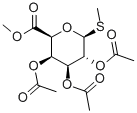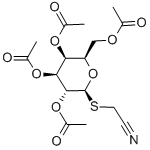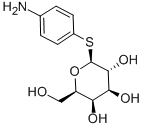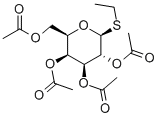METHYLMERCAPTO-D-GALACTOPYRANOSIDE
Synonym(s):Methyl-1-thio-β-D -galactopyranoside;TMG
- CAS NO.:155-30-6
- Empirical Formula: C7H14O5S
- Molecular Weight: 210.25
- MDL number: MFCD00038073
- EINECS: 205-842-4
- SAFETY DATA SHEET (SDS)
- Update Date: 2023-02-14 17:05:08

What is METHYLMERCAPTO-D-GALACTOPYRANOSIDE?
The Uses of METHYLMERCAPTO-D-GALACTOPYRANOSIDE
Inhibition of ?glucosidase
The Uses of METHYLMERCAPTO-D-GALACTOPYRANOSIDE
Inhibition of β-glucosidase.
The Uses of METHYLMERCAPTO-D-GALACTOPYRANOSIDE
Methyl-β-D-thiogalactoside has been used in a study to analyze inducers of the E.coli lac repressor system. It has also been used in a study that investigated the utilization of lactose by Streptococcus faecalis.
What are the applications of Application
Methyl-1-thio-b-D-galactopyranoside is used to study the lac repressor system in bacteria
General Description
The uptake of methyl-β-D-thiogalactoside (TMG), lactose, and glucose is maintained by the phosphoenolpyruvate-dependent phosphotransferase system.
Properties of METHYLMERCAPTO-D-GALACTOPYRANOSIDE
| Melting point: | 115-1170C |
| Boiling point: | 437.3±45.0 °C(Predicted) |
| Density | 1.50±0.1 g/cm3(Predicted) |
| storage temp. | −20°C |
| pka | 12.92±0.70(Predicted) |
| BRN | 81583 |
| CAS DataBase Reference | 155-30-6(CAS DataBase Reference) |
| EPA Substance Registry System | .beta.-D-Galactopyranoside, methyl 1-thio- (155-30-6) |
Safety information for METHYLMERCAPTO-D-GALACTOPYRANOSIDE
| Signal word | Warning |
| Pictogram(s) |
 Exclamation Mark Irritant GHS07 |
| GHS Hazard Statements |
H315:Skin corrosion/irritation H319:Serious eye damage/eye irritation H335:Specific target organ toxicity, single exposure;Respiratory tract irritation |
| Precautionary Statement Codes |
P261:Avoid breathing dust/fume/gas/mist/vapours/spray. P264:Wash hands thoroughly after handling. P264:Wash skin thouroughly after handling. P271:Use only outdoors or in a well-ventilated area. P280:Wear protective gloves/protective clothing/eye protection/face protection. P302+P352:IF ON SKIN: wash with plenty of soap and water. P305+P351+P338:IF IN EYES: Rinse cautiously with water for several minutes. Remove contact lenses, if present and easy to do. Continuerinsing. |
Computed Descriptors for METHYLMERCAPTO-D-GALACTOPYRANOSIDE
New Products
4-AMINO-TETRAHYDRO-PYRAN-4-CARBOXYLIC ACID HCL 4-(Dimethylamino)tetrahydro-2H-pyran-4-carbonitrile 4-Aminotetrahydropyran-4-carbonitrile Hydrochloride (R)-3-Aminobutanenitrile Hydrochloride 3-((Dimethylamino)methyl)-5-methylhexan-2-one oxalate 1,4-Dioxa-8-azaspiro[4.5]decane 5-Bromo-2-nitropyridine Nimesulide BP Aceclofenac IP/BP/EP Diclofenac Sodium IP/BP/EP/USP Mefenamic Acid IP/BP/EP/USP Ornidazole IP Diclofenac Potassium THOMAIND PAPER PH 2.0 TO 4.5 1 BOX BUFFER CAPSULE PH 9.2 - 10 CAP SODIUM CHLORIDE 0.1N CVS ALLOXAN MONOHYDRATE 98% PLATINUM 0.5% ON 3 MM ALUMINA PELLETS (TYPE 73) LITHIUM AAS SOLUTION 2-Bromo-1-(bromomethyl)-3-chloro-5-nitrobenzene 2-Bromo-3-nitroaniline N-(3-Hydroxypropyl)-N-methylacetamide 3-Bromo-6-chloropyridazine 4-ethyl-3-nitrobenzoic acidRelated products of tetrahydrofuran








You may like
-
 Methyl-1-thio-beta-d-galactopyranoside 95% CAS 155-30-6View Details
Methyl-1-thio-beta-d-galactopyranoside 95% CAS 155-30-6View Details
155-30-6 -
 Methyl-β-D-thiogalactoside CAS 155-30-6View Details
Methyl-β-D-thiogalactoside CAS 155-30-6View Details
155-30-6 -
 1823368-42-8 98%View Details
1823368-42-8 98%View Details
1823368-42-8 -
 2-(3-(tert-butyl)phenoxy)-2-methylpropanoic acid 1307449-08-6 98%View Details
2-(3-(tert-butyl)phenoxy)-2-methylpropanoic acid 1307449-08-6 98%View Details
1307449-08-6 -
 Ethyl 3-(furan-2-yl)-3-hydroxypropanoate 25408-95-1 98%View Details
Ethyl 3-(furan-2-yl)-3-hydroxypropanoate 25408-95-1 98%View Details
25408-95-1 -
 2-Chloro-5-fluoro-1-methoxy-3-methylbenzene 98%View Details
2-Chloro-5-fluoro-1-methoxy-3-methylbenzene 98%View Details
1805639-70-6 -
 1784294-80-9 98%View Details
1784294-80-9 98%View Details
1784294-80-9 -
 Lithium ClavulanateView Details
Lithium ClavulanateView Details
61177-44-4
Statement: All products displayed on this website are only used for non medical purposes such as industrial applications or scientific research, and cannot be used for clinical diagnosis or treatment of humans or animals. They are not medicinal or edible.